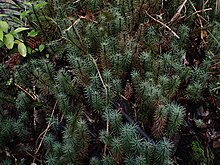Glaucocharis epiphaea
G. epiphaea prefers mountainous habitat and frequents very damp spots including alpine and subalpine moss bogs.
This species was first described by Edward Meyrick in 1885 using specimens collected at Arthur's Pass in January and named Diptychophora epiphaea.
[4][5] George Hudson discussed and illustrated this species under that name in his 1928 book The butterflies and moths of New Zealand.
Forewings broad, triangular, costa hardly arched, apex rounded, hindmargin oblique, slightly rounded, once indented below apex; fuscous, with green reflections; lines slender, irregularly denticulate, dark fuscous; first line from beyond 1⁄3 of costa to before middle of inner margin, angulated above middle and bent inwards below middle; discal spot obsolete or represented by a faint darker suffusion; second line from 3⁄4 of costa to 3⁄4 of inner margin, angulated above middle, thence tolerably straight; sometimes two or three whitish longitudinal streaks towards hindmargin above middle; a small black apical spot : cilia whitish, with a shining dark grey basal and lighter median line.
[1][8] This species prefers mountainous habitat and can be found near or just above the upper limit of native forest and frequents very damp spots.

